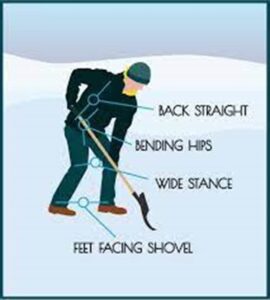Snow shoveling is a repetitive activity that can cause muscle strain to the lower back and shoulders. Back injuries due to snow shoveling are more likely to happen to people who may not know that they are out of condition.
Whitney Young Health Physical Therapist, Dr. Dayle Carthart-Davis, shares safety tips for snow shoveling this year.

Before Shoveling:
- Put salt down as early as possible to make sure no ice is hiding under the snow.
- Do some light stretching/warm up in your home for ~5 minutes to prepare your body/muscles.
- Make sure you are hydrated and have good footwear on with warm socks.
- Shovel type matters!
- Nonstick shovels make snow come off easier, which makes you less tired
- Shovels with adjustable heights are better for your posture and reduce injury risk
- Make sure you have your phone or emergency alert button on you if you are alone
While Shoveling:
- The more snow falls the heavier it gets, try getting out as early as possible to shovel so it’s lighter. Yes, it means more trips outside but could greatly reduce fatigue and injury.
- Did you know that one shovel of snow can weigh up to 20lbs?! Push the snow instead of lifting it (only possible if snow isn’t too deep)
- If you need to lift the snow, maintain good posture!
- Feet shoulder width apart, bend at your knees/hips and NOT at your back (like a squat)
- Keep the shovel closer to your body.
- Switch between shoveling snow with your right hand and left hand, so then you are using different muscles.
- Do not throw snow over your back, instead, take steps to turn and place the snow.
- Take breaks! Especially if you have any cardiovascular or pulmonary conditions.
- Shoveling is a vigorous exercise and places a lot of work on your heart and lungs, taking breaks will help reduce the risk of any events happening. Listen to your body!
After Shoveling:
- Stretch after you’re done to give your muscles a break.
- Drink water
Stay tuned for more physical therapy tips, exercises, and more!
